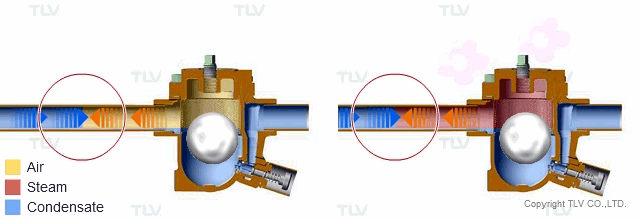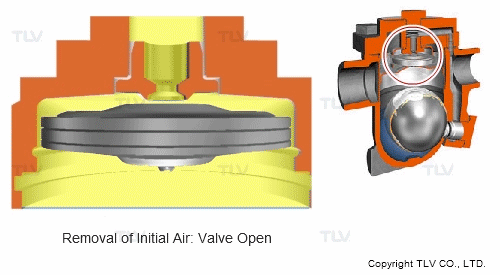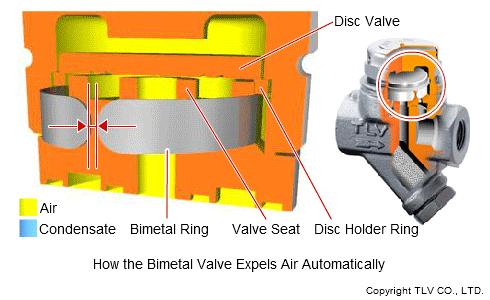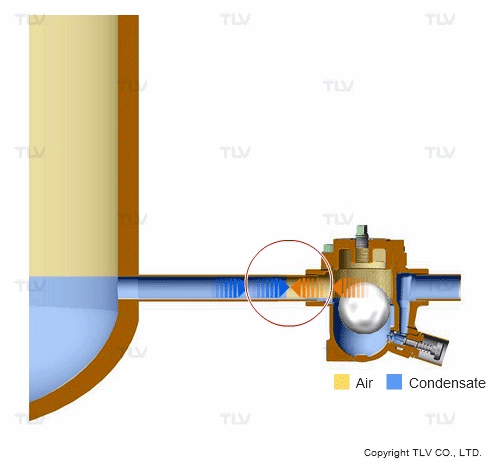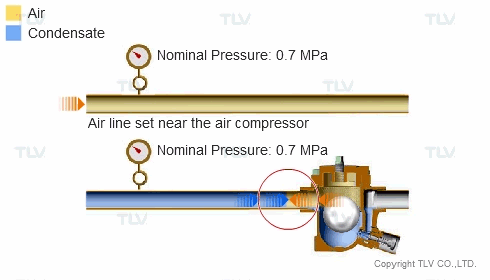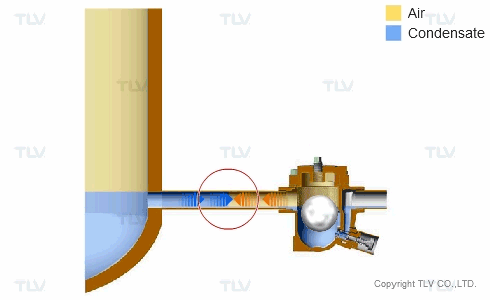- Home
- Steam Resources
- Steam Theory
- Air Binding
Steam Trap Problems
Air Binding
What is Air Binding?
"Air binding" is a problem that typically occurs in steam, air or gas traps where a non-condensable gas such as air causes the trap valve to remain closed, impeding condensate discharge.
This problem occurs because steam/air/gas traps are automatic valves designed to:
- Smoothly remove condensate
- Prevent the discharge of the steam/air/gas, respectively (i.e. the fluid being transported)
So the occurrence of air binding simply means that the operating mechanism of the trap is functioning properly.
| Issue of Air Binding in a Process |
|---|
|
|
| Unlike steam, air does not easily condense, and can remain trapped within the body of a steam/air/gas trap, causing a problem known as air binding. |
The mechanism behind air binding is similar to steam locking. The main difference between the two problems is that with steam radiation heat loss causes a decrease in pressure/temperature of the steam which eventually causes it to condense, allowing condensate to be slowly discharged. Air, on the other hand, does not condense, leaving the problem unresolved.
| Difference Between Air Binding and Steam Locking | |
|---|---|
|
|
|
|
When air binding occurs, the problem does not resolve itself on its own because air does not condense from radiant heat loss. |
When steam locking occurs, the problem may resolve itself on its own because steam can condense through radiant heat loss.
Note: The problem may still reoccur at the following discharge cycle. |
Countermeasures for Steam Traps
Countermeasures against air binding differ depending on whether the problem occurs in a steam trap or an air/gas trap.
For steam traps, the problem is typically fixed by installing a steam trap that is equipped with a built-in automatic vent to discharge non-condensable gases such as air. This is possible because the air and other non-condensable gases are not being used by the process. Rather, they are unwanted fluids mixed in with steam.
Since piping is typically at ambient temperature at start-up, many air vents use an opening/closing mechanism that is based on the temperature difference between air and steam: the air vent valve remains forcibly open at cooler temperatures to allow air to be discharged out of the system, and closes when warmed by steam to prevent the unwanted discharge of steam.
Many steam systems use traps fit with either an X-element or bimetal strip to allow non-condensable gases such as air to automatically move downstream of the trap, allowing for smooth condensate discharge.
Automatic Air Venting Mechanisms
| Air Venting Using an X-Element |
|---|
|
|
| The opening and closing of an X-element air vent is based on the expansion and contraction of an internal element that contains either an alcohol based mixture with a boiling point lower than that of water, or a bimetal element that bends below 100 °C. |
| Air Venting Using a Bimetal Strip |
|---|
|
|
| The bimetal strip remains contracted when cold, keeping the valve seat open and allowing air to be rapidly discharged. |
Countermeasures for Air/Gas Traps
A different method is usually used to resolve air binding problems that occur in air or gas traps because the air/gas typically causing the problem is also being used for the process and should not be wasted.
In this case, the air or gas should be returned to a larger space that can receive it by installing a pressure-balancing line. This should allow condensate to be properly discharged through the trap. Pressure balancing lines are an extremely common and effective way of resolving air binding problems in these types of traps, and further information on their installation should be available in your air/gas trap instruction manual.
| Adding a Pressure-balancing Line to an Air Trap |
|---|
|
|
When installing a pressure-balancing line, it is important to make sure that pressure is well-balanced. The higher density condensate should remain in the lower part of trap, while the lower density air/gas should remain in the higher part of the trap so that it can be returned to the process. This configuration should allow for the smooth discharge of condensate.
Pressure-balancing Line Configuration Tips
Pressure balancing lines require a very precise setup. If the line is not well balanced and pressure rises too much, backflow of air/gas can occur, making the problem worse than before. Similarly, pressure loss in a pressure-balancing line that has a too small diameter can prevent air/gas from being properly transported out of the trap.
| Issue with High Back Pressure of Pressure-balancing Line |
|---|
|
|
| If the line is not well balanced, backflow of air/gas can occur, making the problem even worse that before. |
| Issue with Diameter of Pressure-balancing Line |
|---|
|
|
| The diameter of the pressure balancing line must be large enough to allow for sufficient removal of the trapped air/gas. |
It's also important to note that a pressure-balancing line is often not required with air/gas traps installed at the bottom of a vertical line because the liquid and gas should be able to freely move about, limiting problems from air binding.
Additional Note
Whether your system uses steam traps or air/gas traps, piping should always be configured in a way to allow for smooth and rapid discharge of condensate.
In general, traps should not be installed at the top of vertical sections of piping, and inlet piping should be as short as possible and have a diameter as large as possible to reduce chances of air binding.

